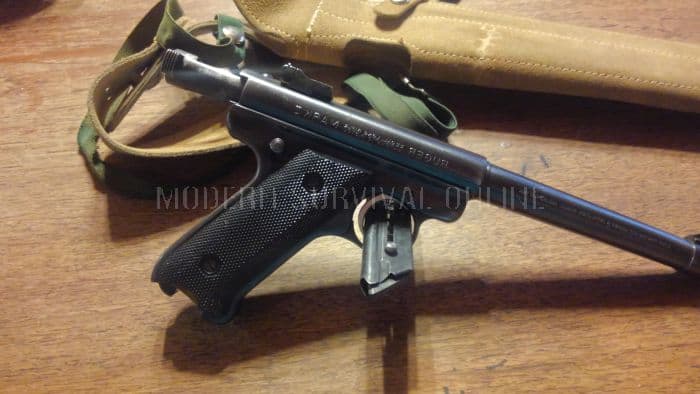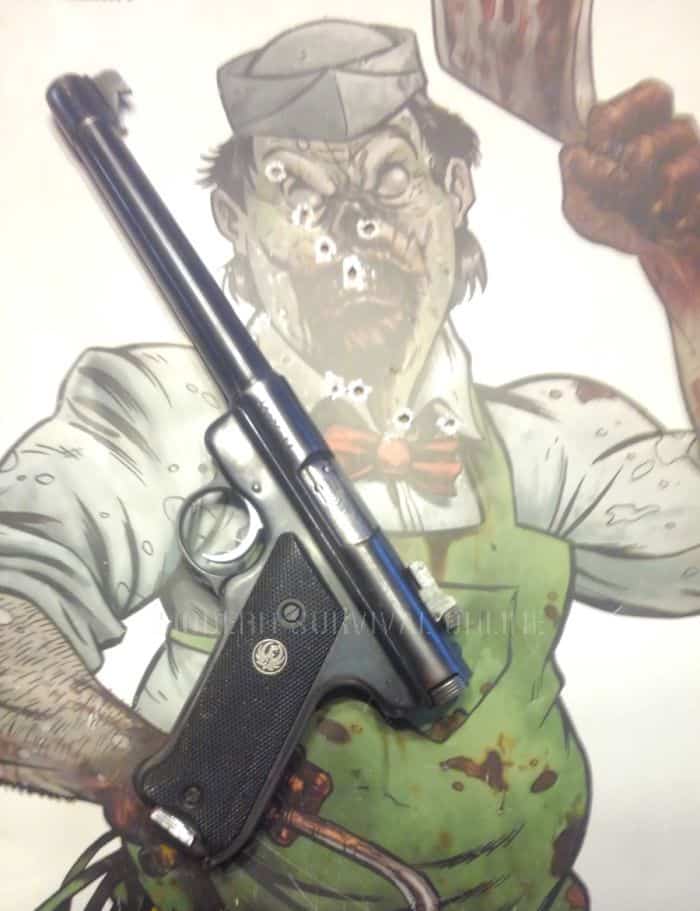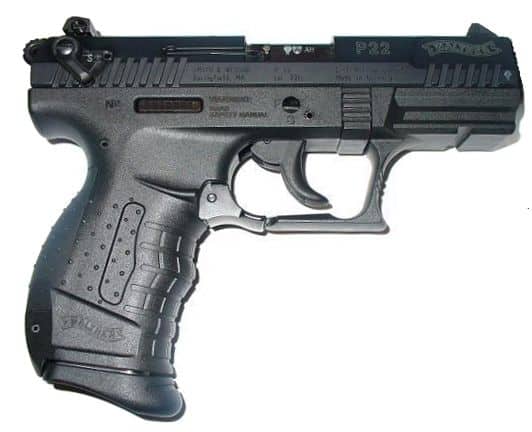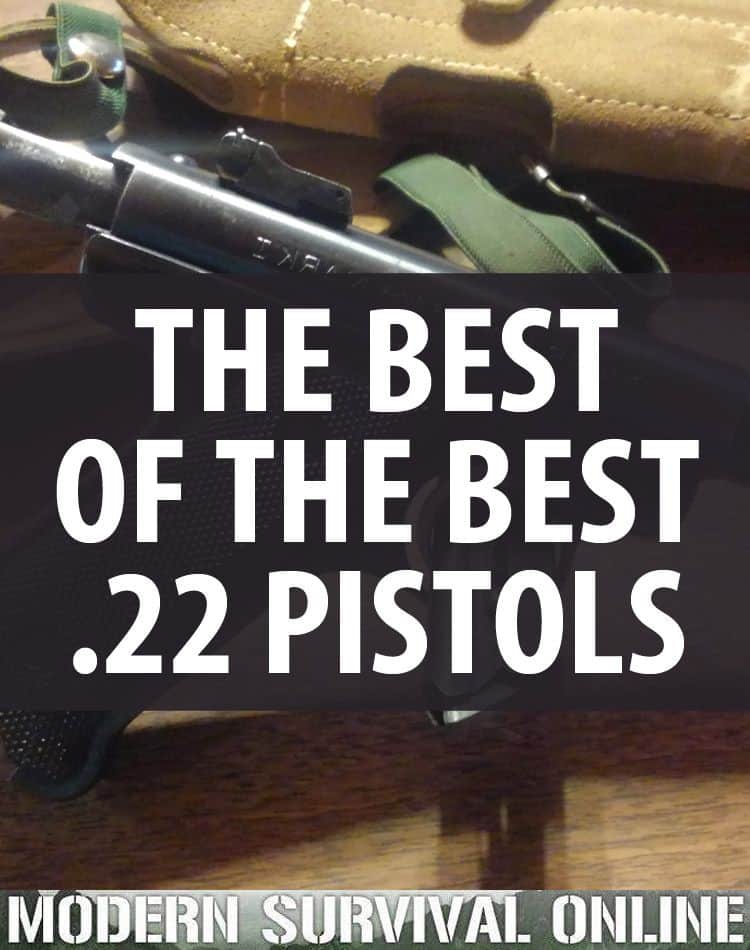by Charles
There is no such thing as a gun suitable for one and all, for every shooter. But if there was, if there was one gun that damn near everyone in the world could make use of, if would be a .22 LR pistol; the one, true, jack-of-all-trades, Swiss Army knife firearm.
From small game hunting to fundamentals training to self-defense, there is very little that this mighty mouse combination cannot handle. It might not be able to do everything excellently, but it can do almost anything passably.
Let no shooter ever say they have outgrown their .22. In this article, we’ll be giving these guns a brief highlight reel as a class and then I’ll offer up my recommendations for the best in the breed. Many of you will already have a .22 handgun (or five), but some of you might not. At any rate, you are bound to come away with some new information and insights about the littlest rimfire that could.
So grab a brick of ammo and let’s get started.

.22 LR Specifics
The .22 LR has been around for quite some time, and is one of the oldest and certainly the most ubiquitous of American cartridges, and also the rimfire cartridge around the world. Conceived in the late 1880’s, the .22 LR was not really an innovation. Rimfire priming and metallic cartridges had been around for some time, and specifically in .22 and even smaller calibers.
The .22 Long Rifle was created by combining the bullet of the .22 Extra long with the shorter case of the .22 Long. That isn’t a typo, by the way, those are two distinct cartridges. In no time at all, it gained popularity as an ideal “intermediate” rimfire .22, one suitable for all kinds of shooting activities and chores. A star was born, and time would see the .22 LR validated and enshrined all the way to today as the standard small bore rimfire round.
Generations’ worth of shooters, countless in number, learned to shoot on a .22 rifle or pistol. Its nearly non-existent recoil, minimal noise and blast make it an easy gun to learn on as a novice, and ideal for seasoned shooters to train on to refine or develop their fundamentals. The .22 LR is an ideal small game cartridge, and has a proud history bringing home meat for stew pots around the world. And though it is a far cry from a larger “serious” round, the .22 LR is more than capable of inflicting lethal wounds, making it a viable option for a special-purpose defense gun or one for users who simply cannot handle a larger firearm.
While one of its parents and a cousin, the .22 Long and .22 Short, are still extant today, you have to look fairly hard to find them in most shops and stores. In comparison, the bounty of .22 LR seems to go on forever (minus some serious long term shortages a few years back). Aside from the sheer quantity of ammo produced, there is a mind-boggling variety of loads available.
Everything from modestly-quick lead round nose to scorching-fast plated hollowpoints is readily available on the shelves of any gun shop worth the name. More exotic specialty loads range from tiny shotshell-like pest and varmint ammo to primer-only CB caps, which produce a report only a little louder than your average airgun.
No matter the task or desire- hunting, plinking or self-defense, there is a .22 LR load to suit.

Beyond Plinking: .22s’ Real World Application
A .22 LR pistol is, naturally, a world class slayer of cans, bottles, produce and paper, but it is capable, even made, for so much more. I have already touched on its suitability for small game hunting, and it is one of only a few calibers that can reliably harvest smaller animals without severely damaging pelt and meat. Combined with the .22 LR’s reputation for excellent accuracy when a good round and gun are paired this makes for easy harvesting of smaller and hard-to-hit critters.
Your average .22 LR load presents minimal chances of overpenetration and a far milder report than larger centerfire calibers of all types. Together this makes it uniquely suited for pest disposal in suburban and urban settings where removal of unwanted animals is sometimes necessary but lighting off the heavy artillery is frowned upon.
When it comes to refining existing skills, honing skills or developing new techniques, a .22 pistol is peerless. A model that is similar or even identical to a shooter’s larger “serious” pistol will make an excellent training aid and allow near 100% fidelity in live fire practice with a couple of significant perks: first, the minimal report and blast as discussed are much less likely to start cementing or causing an anticipatory reflex in the shooter. Second, the very low cost of .22 LR allows a far higher volume of live fire training than any centerfire cartridge would.
This allows better training reps to be had at a much smaller price tag, and with the cost of ammo today, even if you reload, you can be looking at serious outlay of cash for high volume training. 1,000 rounds of .22 LR will only set you back $35-40 for bulk economy ammo.
Self-defense with a .22 LR is often scoffed at by seasoned and salty shooters, and I will be the first to condemn it when other, more powerful cartridges make more sense, but chosen with deliberation a .22 LR can be just what the doctor ordered.
The typical .22 LR pistol is very light, has little to virtually no recoil, are usually easy to operate and is simple to shoot quickly, and well. All are assets for those who are suffering from an injury or infirmity, or those who simply lack the strength to run the slide on a more powerful semi-auto. For adept shooters who need a very small firearm to conceal, or use as a backup, a tiny .22 makes sense: they are often times much easier to shoot well than similarly sized guns with more powerful chamberings.
They can even make sense as a primary weapon when an ultralight, ultra-quiet ballistic solution is needed. A modern .22 pistol fully kitted with optic and suppressor makes for very, very discreet problem solving capability when one wishes to stay lightly encumbered and unnoticed, while still retaining all of its other desirable qualities and allowing you to carry an absolute ton of ammo compared to another gun.
That is definitely something to consider for a true bug-out or survival gun.
Special Considerations for Defensive Use of .22 LR
The .22 LR is not, not an ideal cartridge for self-defense. But it can work well enough, so long as you work to overcome its flaws. A few things to keep in mind when considering a .22 LR for any defensive capacity.
- Don’t believe the bunk: a .22 is not going to bounce around all over the inside of an assailant’s body and carve them up, because physics. Any tales to the contrary are complete hogwash.
- In accordance with the above, ammo selection is important with a .22 LR for best results. .22’s are tiny, fragile bullets that quickly lose momentum inside a body. This can lead to a lack of much needed penetration. Choose a 40gr., copper plated high velocity load for defense, CCI’s Velocitor or Mini-Mag are good standbys. Stingers are a hair too fast leading to early upset and loss of weight. Not ideal.
- A good .22 pistol loaded with quality ammo is extremely reliable; .22’s are unfairly categorized as unreliable due to their rimfire priming. While this has historical merit upwards of 70 plus years ago, modern rimfire ammo is very reliable so long as high-quality ammo is used, i.e. not bulk pack plinking fodder.
So long as you use a little common sense and follow best practices, a .22 LR can work as a special purpose defensive gun. Once again, if you are choosing a .22 LR when another full-power cartridge is both available and workable, you are probably wrong.
The Best .22 Pistols
All of the handguns on the list below, both semi-autos and revolvers, are chosen first and foremost for their reliability and suitability as both survival and defensive options. Yes, most of them are superb general purpose handguns too, but not all .22 handguns are suitable for self-defense.
Some are old, some are new, but all are robust, durable and good shooters, so long as you can supply the ammo and some ability.
Ruger Mark IV 22/45 Tactical
Ruger’s 22/45 series of pistols are great all-around handguns, but have always had special merit as training pistols because, aside from their light weight, they handle like a larger pistol. Grip dimensions, control layout the works. Compared to earlier iterations they enjoy oversized controls for positive operation and a far, far simpler disassembly procedure. Ask any 22/45 owner who has an earlier model how much fun it is taking them apart and brace yourself for a stream of invective.
The 22/45 is excellent for regular sharpening of skills when you don’t want to spend a fortune in ammo, but things keep on getting better; these are reliable rimfires, and even more so when stoked with quality ammo. Certainly reliable enough for defensive purposes and they run well with minimal maintenance so long as they are kept reasonably lubed.
Considering the package, a top rail for optics, underbarrel rail for lasers or lights and a threaded barrel for a suppressor means the 22/45 can be configured appropriately as you would any “proper” defensive handgun. One of these pistols equipped with a red dot, suppressor and light/laser combo is quite the shooting machine, one you should laugh at your peril.
Topping it all off, there is enormous aftermarket support for these pistols from all kinds of manufacturers, and you can get everything from better triggers or grips to entirely new barreled actions at the click of a mouse.
I would not feel under armed if I were bugging out with my BOB, one of these nice pistols and a brick of Eley or CCI ammo.
Ruger LCRx .22 LR
Ruger’s internal hammer LCR in .38 Spl. hit the market at a time when snub revolvers were just starting to see the promise of a renaissance. Boy, did they make a splash! Combining a new trigger mechanism, polymer trigger housing and alloy frame and barrel shroud with only a steel barrel liner and a cylinder that was radically machined to reduce weight to a minimum, the LCR was a flyweight among flyweights.
Ever better, it came with a stock trigger that would handily beat the triggers on most fullsize factory revolvers from any manufacturer! It wasn’t long before a flood of variants followed in the wake of that first successful version, and soon we enjoyed a .357 Magnum version, a .327 Fed. Magnum version and a .22 LR and .22 Magnum.
Then Ruger, ever conscious of what their customers and the core of the shooting demographic wants, introduced a version with a traditional exposed hammer, and the LCRx was born, and logically soon there were plenty of calibers to pick from, and some of those include a longer 3” barrel. That very setup is my pick for a slick shooting .22 revolver par excellence.
The LCRx .22 LR is an ideal .22 revolver if you can get past its super modern aesthetics and use of plastic. I know how you traditional revolver guys roll! The LCRx has very good sights, an uncommonly excellent trigger and is so light, even fully loaded, you might forget you have it on. This makes it a fine primary gun any time you require a .22 or a backup you can stash in your BOB or Go-Bag with a few hundred rounds of ammo.
All this at a price less than many old-school steel .22 revolvers, and without many of their hiccups.

photo of a Walther P22, by The original uploader was Davken1102 at English Wikipedia. – Transferred from en.wikipedia to Commons., CC BY-SA 3.0, Link
Walther P22
The P22 is coming up on a couple of decades old here pretty soon. That’s with cause, as this little polymer .22 turned the rimfire pistol market up on its end when it premiered in 2002. Looking just like a miniature P99, Walther’s then groundbreaking polymer service pistol (still going strong today, by the way) the P22 departed from traditional .22 handgun design and set a new standard for layout that remains in effect today.
The P22’s controls were configured by and large like its big brother P99’s; a Euro-style paddle magazine release, a slide release in the conventional location, slide serrations forward and rear and an accessory rail (albeit a small one) for a compact aiming laser or light. The addition of a threaded barrel for suppressor usage and a slide located manual safety were the only departures from the features of the P99.
In effect, the P22 makes a handy trainer for a larger, but similarly styled pistol, and also is an admirable firearm in its own right: accurate, easy to shoot well, light, reliable (so long as high velocity ammo is used) and easy to maintain. The inclusion of sights that were more typical of service handguns further cemented the notion that the P22 was not your grandpappy’s .22 pistol.
As a trainer gun or pistol for a youth, it is excellent, and also an inspired choice for a “just in case” gun as part of a stash or as a backup gun.
Ruger GP100 -1766 .22 LR
Ruger’s GP100 needs no introduction among revolver fans, and its famed performance in .357 Magnum is the subject of much fanfare. Unknown to some is its newer chambering in .22 LR with a whopping 10 round cylinder, and the 1766 model has a 4 ¼” barrel with an excellent fiber optic front sight and fully adjustable rear. This may seem like an odd pairing at first blush: the massive, heavy GP100 action chambering the diminutive .22. Upon closer inspection this confers several advantages.
First, the GP100 action is one of the strongest and most robust, if not the most, among large frame revolvers. While it will take an awful lot of .22 to even begin to weather that mighty action, it still provides a certain amount of assurance that no weather and few hard knocks will hamper the performance of this beastly rimfire.
Second, the GP100 action is comparatively easy to service next to other, older revolver designs. The entire trigger mechanism can be detached intact from the frame proper, allowing simpler service, inspection and replacement of all those delicate parts that drive most sane shooters to a semi auto.
Lastly, the GP100 as a model makes use of a peg-style frame that allows nearly any grip imaginable to be mounted; slim, thick, ergonomic, square butt, round butt and more. This conveys a considerable amount of options to shooters of any size, and means no matter what your preference is in a grip, you’ll be able to find and install one on the GP100.
The GP100 is known for a highly reliable, but somewhat middling double action pull, and on the .22 version this has not changed. Single action remains as crisp as ever, and with a little use and perhaps some work the gun will smooth up considerably. It may be massive and heavy for a .22, but if you want a rimfire revolver built to withstand the apocalypse, this is it.
Conclusion
Almost everyone needs a .22 caliber pistol. From sharpening your skills and developing new techniques to survival and self-defense, a good .22 will always earn its weight in your kit. If you don’t have a .22 already, consider adding one of the above to your collection, or find another that will work for you.

via Modern Survival Online http://bit.ly/2GDZWo7
No comments:
Post a Comment